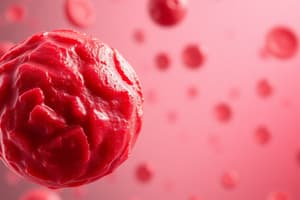Podcast
Questions and Answers
Which of the following is a type of blood disorder?
Which of the following is a type of blood disorder?
- Arthritis
- Anaemia (correct)
- Hypertension
- Diabetes
What is the primary role of haemoglobin?
What is the primary role of haemoglobin?
- To digest food
- To fight infections
- To clot blood
- To carry oxygen (correct)
Iron deficiency is a cause of which condition?
Iron deficiency is a cause of which condition?
- Iron Deficiency Anaemia (correct)
- Leukaemia
- Lymphoma
- Thalassaemia
What is a common oral manifestation of anaemia?
What is a common oral manifestation of anaemia?
Vitamin B12 deficiency can result in which type of anaemia?
Vitamin B12 deficiency can result in which type of anaemia?
Vegans are most at risk of
Vegans are most at risk of
Sources of folate are
Sources of folate are
What is a potential consequence of folate deficiency during pregnancy?
What is a potential consequence of folate deficiency during pregnancy?
Sickle cell disease is what type of inherited condition?
Sickle cell disease is what type of inherited condition?
People of what descent are most commonly affected by sickle cell disease?
People of what descent are most commonly affected by sickle cell disease?
Which term describes the event when misshapen red blood cells clog blood vessels in sickle cell patients?
Which term describes the event when misshapen red blood cells clog blood vessels in sickle cell patients?
In dentistry, what is a consideration for treating patients with sickle cell trait?
In dentistry, what is a consideration for treating patients with sickle cell trait?
In what population groups does Thalassaemia mostly occur?
In what population groups does Thalassaemia mostly occur?
In thalassaemia, what is the problem with the red blood cells?
In thalassaemia, what is the problem with the red blood cells?
What is a key feature of aplastic anaemia?
What is a key feature of aplastic anaemia?
Aplastic anemia can result in which of the following symptoms?
Aplastic anemia can result in which of the following symptoms?
What is the primary cause of anaemia of chronic disease?
What is the primary cause of anaemia of chronic disease?
Which of the following conditions is often associated with anaemia of chronic disease?
Which of the following conditions is often associated with anaemia of chronic disease?
What process is affected in leukaemia?
What process is affected in leukaemia?
What is the result of proliferating immature blast cells in leukaemia?
What is the result of proliferating immature blast cells in leukaemia?
What are some risk factors for developing leukaemia?
What are some risk factors for developing leukaemia?
Which type of leukaemia is most common in children?
Which type of leukaemia is most common in children?
Acute lymphoblastic leukaemia results in which of the following?
Acute lymphoblastic leukaemia results in which of the following?
Which statement is true about Acute Myeloid Leukaemia?
Which statement is true about Acute Myeloid Leukaemia?
What population group is mostly affected by Chronic Myeloid Leukaemia?
What population group is mostly affected by Chronic Myeloid Leukaemia?
Which signs may indicate leukaemia?
Which signs may indicate leukaemia?
What is a common oral feature in leukaemia patients?
What is a common oral feature in leukaemia patients?
What is the recommendation for a dental team treating leukaemia patients experiencing chronic illness?
What is the recommendation for a dental team treating leukaemia patients experiencing chronic illness?
Multiple myeloma is a disorder of which cells?
Multiple myeloma is a disorder of which cells?
What is a key feature of myeloma?
What is a key feature of myeloma?
What part of the body does Lymphoma affect?
What part of the body does Lymphoma affect?
What is a common dental implication for patients undergoing radiotherapy or chemotherapy?
What is a common dental implication for patients undergoing radiotherapy or chemotherapy?
Patients on long term bisphosphonates may be at risk of?
Patients on long term bisphosphonates may be at risk of?
What is an important consideration for managing dental treatment in patients with myeloma or lymphoma?
What is an important consideration for managing dental treatment in patients with myeloma or lymphoma?
Leukaemia starts in which part of the body?
Leukaemia starts in which part of the body?
The cancerous cells from Lymphoma tumours aggregate and form in?
The cancerous cells from Lymphoma tumours aggregate and form in?
Myeloma is a tumour where the body prodocues too many..?
Myeloma is a tumour where the body prodocues too many..?
Which of the following is a characteristic of iron deficiency anaemia?
Which of the following is a characteristic of iron deficiency anaemia?
Which of the following is a cause of Vitamin B12 deficiency?
Which of the following is a cause of Vitamin B12 deficiency?
What is required for Vitamin B12 absorption?
What is required for Vitamin B12 absorption?
What food source is a good source of Vitamin B12?
What food source is a good source of Vitamin B12?
What type of anaemia is caused by issues with absorption in intestines?
What type of anaemia is caused by issues with absorption in intestines?
What is the role of folic acid in the body?
What is the role of folic acid in the body?
Where is folate absorbed?
Where is folate absorbed?
Why do patients with Thalassaemia need to take extra care with infection control?
Why do patients with Thalassaemia need to take extra care with infection control?
What happens to the red blood cells in thalassaemia?
What happens to the red blood cells in thalassaemia?
What is the underlying issue in aplastic anaemia?
What is the underlying issue in aplastic anaemia?
Anaemia of chronic disease is associated with?
Anaemia of chronic disease is associated with?
What is the cause of leukaemias?
What is the cause of leukaemias?
What does the bone marrow make in Acute Myeloid Leukaemia?
What does the bone marrow make in Acute Myeloid Leukaemia?
What symptoms do patients often have with leukaemia, lymphoma and myeloma?
What symptoms do patients often have with leukaemia, lymphoma and myeloma?
A key feature of Lymphoma is cancerous cells aggregate and form in?
A key feature of Lymphoma is cancerous cells aggregate and form in?
Flashcards
What is Anaemia?
What is Anaemia?
A condition with reduced oxygen-carrying capacity in the blood, below 11.5 g/dL for females and 13.5 g/dL for males.
What is Iron Deficiency Anaemia?
What is Iron Deficiency Anaemia?
A condition where iron deficiency reduces red blood cell production, making them smaller and paler.
What are Clinical Features of Iron Deficiency?
What are Clinical Features of Iron Deficiency?
Fatigue, breathlessness, palpitations, pallor, headache, brittle nails, and koilonychia (spoon-shaped nails).
Dental Signs of low iron?
Dental Signs of low iron?
Signup and view all the flashcards
How to handle Anemia?
How to handle Anemia?
Signup and view all the flashcards
Why is B12 important?
Why is B12 important?
Signup and view all the flashcards
What causes Vitamin B12 deficiency?
What causes Vitamin B12 deficiency?
Signup and view all the flashcards
Dental Signs of Low B12?
Dental Signs of Low B12?
Signup and view all the flashcards
How do you treat low B12?
How do you treat low B12?
Signup and view all the flashcards
Folate acid needs?
Folate acid needs?
Signup and view all the flashcards
Dental Signs of Low Folate?
Dental Signs of Low Folate?
Signup and view all the flashcards
Dental Signs of Low Folate?
Dental Signs of Low Folate?
Signup and view all the flashcards
What causes fetal tube defects?
What causes fetal tube defects?
Signup and view all the flashcards
Causes of Haemolytic Anaemias?
Causes of Haemolytic Anaemias?
Signup and view all the flashcards
Inherited Haemolytic Anaemias?
Inherited Haemolytic Anaemias?
Signup and view all the flashcards
Sickle Cell Disease?
Sickle Cell Disease?
Signup and view all the flashcards
Sickle Cell Crisis?
Sickle Cell Crisis?
Signup and view all the flashcards
What causes Sickle Cell Crisis?
What causes Sickle Cell Crisis?
Signup and view all the flashcards
Sickle Cell Trait Treatment?
Sickle Cell Trait Treatment?
Signup and view all the flashcards
How to manage Sickle Cell Disease?
How to manage Sickle Cell Disease?
Signup and view all the flashcards
Who is affected by Thalassaemia?
Who is affected by Thalassaemia?
Signup and view all the flashcards
How to manage Aplastic?
How to manage Aplastic?
Signup and view all the flashcards
Signs of Chronic?
Signs of Chronic?
Signup and view all the flashcards
What is Leukaemia?
What is Leukaemia?
Signup and view all the flashcards
Types off Leukaemia?
Types off Leukaemia?
Signup and view all the flashcards
Dental signs of Leukaemia?
Dental signs of Leukaemia?
Signup and view all the flashcards
Multiple Myeloma?
Multiple Myeloma?
Signup and view all the flashcards
What is Lymphoma?
What is Lymphoma?
Signup and view all the flashcards
How to treat Lymphoma?
How to treat Lymphoma?
Signup and view all the flashcards
How to treat Lymphoma?
How to treat Lymphoma?
Signup and view all the flashcards
Study Notes
- Blood disorders include anaemias, leukaemias, other dyscrasias like multiple myeloma and lymphoma, and bleeding disorders
Anaemias
- Anaemias involve a reduced oxygen-carrying capacity in the blood.
- Females: below 11.5 g/dl is considered anaemic
- Males: below 13.5 g/dl is considered anaemic
- Haemoglobin is essential for carrying oxygen; insufficient or abnormal red blood cells reduce this capacity.
Deficiency Anaemias
- Deficiency anaemias are a result of lacking essential nutrients
- Iron deficiency is a condition where a lack of iron reduces the number of red blood cells; cells are smaller, paler, and carry less haemoglobin.
- Iron Deficiency Causes: dietary deficiency, chronic blood loss, malabsorption, and pregnancy.
- Vitamin B12 deficiency requires B12 to synthesise DNA & RNA
- Vitamin B12 deficiency depends on intrinsic factor secretion by parietal cells
- Vitamin B12 deficiency requires the terminal ileum which absorbs the B12-intrinsic factor complex
- Vitamin B12 deficiency causes can be diet-related (vegans at risk from lacking meat and dairy), or impaired absorption (Crohn's, Pernicious Anaemia).
- Folate (folic acid) is needed to synthesise DNA & RNA and to build new cells including red blood cells
- Folate is found in fresh leafy & other vegetables
- Folate is absorbed from the small intestine
- The body has virtually no stores of folate
- Folate deficiency is mostly due to dietary deficiency
Clinical Features of Anaemias
- Common symptoms include fatigue, lethargy, breathlessness, palpitations, pallor, headache, and brittle nails (koilonychia).
- Pale oral mucosa occurs
- Atrophic glossitis, recurrent aphthous ulcers, angular cheilitis, and burning mouth syndrome are also features.
- Reduced RBCs and enlarged cells occur in Vitamin B12 deficiency, develops slowly, and causes fatigue, pallor, breathlessness with dental changes simlar to other deficient anaemias
Management of Anaemias
- Management involves checking medical history, detecting the underlying cause (refer to GP), and iron supplements
- The approach should involve preventative dental measures, regular maintenance, and awareness that patients are more prone to infection.
- Treatment for deficiency involves correct diagnosis and replacment of B12 with hydroxocobalamin
- Good preventative dental care and regular recall intervals
Folate Deficiency
- Dental signs mimic other deficiency anaemias which include glossitis, recurrent ulcers, angular cheilitis and red beefy tongue
- A condition which can result in fetal neural tube defects such as spina bifida or cleft lip/palate
- Treating is done with daily oral folic acid and improved diet
Haemolytic Anaemias
- Haemolytic Anaemias can be inherited or acquired
- Inherited haemoglobinopathies include sickle cell disease and thalassaemia.
- Acquired haemolytic anaemias include viral/bacterial infections, medicines (penicillin, antimalarials), blood cancers, autoimmune disorders (lupus, rheumatoid arthritis), overactive spleen, mechanical heart valves, and reactions to blood transfusions.
Inherited Haemolytic Anaemias
- They are genetically determined disorders of haemoglobin synthesis.
- The inherited conditions include sickle cell disease/trait and thalassaemia/trait.
Sickle Cell Disease
- It is an autosomal recessive genetic disease affecting haemoglobin production, associated with intermittent acute crises and most common in people of African descent
- Unlike healthy red blood cells (highly deformable disks), affected cells are rigid and irregularly shaped
- Sickle cell can cause episodes of severe pain, damage to vital organs, and death
Sickle Cell Trait
- It is when a person inherits the sickle cell gene from one parent
- People with sickle cell trait are generally healthy carriers with no related health problems.
- If two people with SC trait have a child, the child may inherit sickle genes and have SC disease
Sickle Cell Crisis
- Low oxygen states may be brought on by exercise, stress, dehydration, infection, trauma, and general anaesthetic.
- Misshapen red blood cells clog blood vessels impairing blood flow and causes severe pain, clotting and death
Dental Clinical Features of Sickle Cell
- Tongue: Papillary atrophy
- Neuropathic pain and altered sensation
- Aseptic pulp necrosis
- Osteomyelitis
- Delayed dental eruption
- Mucosal pallor
- Bone pain
- Fungal infections
Sickle Cell Management by Dental Clinician
- Sickle Cell Trait requires normal treatment except to avoid GA
- Sickle Cell Disease often require special treatment centre
- Sickle Cell Disease requires +++ proventive dental care and infection control
- Antibiotic prophylaxis for invasive dental treatment
- GA is contraindicated, but conscious sedation can be used with caution
- Stress avoidance and good LA pain control
- Avoid vasoconstrictors
- Avoid NSAIDs, but paracetamol is okay
Thalassaemia
- Thalassaemia largely occurs in people with Mediterranean, Middle/Far Eastern or Asian ancestries
- Characterised by abnormal amounts of haemoglobin from two parents: is an inherited disease
- Affected red blood cells are fewer and more fragile which can cause early haemolysis and anaemia.
Types of Thalassaemia
- Alpha-thalassaemias:
- Mostly found in Asians
- Have 4 subtypes with varying degrees of severity
- The major type is lethal in utero or infancy
- Beta-thalassaemias:
- Mainly affect the Mediterranean & Caribbean populations
- Have 2 types: homozygous ẞ-thalassaemia major / heterozygous ẞ-thalassaemia minor
Symptoms of ẞ-thalassaemia
- Homozygous (major):
- Chronic anaemia, marrow hyperplasia, skeletal deformities, splenomegaly, cirrhosis, gallstones & iron overload
- Iron overload causes cardiac problems and deposits in salivary glands, which leads to; liver & pancreatic dysfunction & dry mouth.
- Pallor and tiredness
- Heterozygous (minor):
- Much more common & mostly asymptomatic
Orofacial Manifestations of Thalassaemia
- Lateral skull x-rays: ‘Hair on end' appearance
- Prominent maxillae, front bossing (bone marrow expansion)
- Spacing and forward drifting of maxillary incisors
- Painful swelling of parotid salivary glands & xerostomia
Thalassaemia - Management
- Management: Severe cases necessitates treatment in hospital clinics
- Care is infection control is cruicial, as multiple blood transfusions occur, and may expose thalassaemia patients to blood borne diseases
- Required is a preventative dental care regimes
Aplastic Anaemia
- Aplastic Aneamia is when bone marrow is depressed which leads to fewer blood cells of all types
- Aplastic Aneamia causes can be idiopathic (autoimmune), genetic, cytotoxic drugs, radiation, certain chemicals, malignancy (leukaemia), and viral infection, with occassional antibiotic causes
- It may present with severe bruising, fatigue, pallor, palpitations, and dyspnoea
- Management is removal of cause, immunosuppressant therapy, and bone marrow transplant
Anaemia of Chronic Disease
- Key features include anaemia and evidence of immune system activation.
- Decreased red blood cell production and increased haemolysis
- Chronic infections (HIV), autoimmune disorders (rheumatoid arthritis), chronic diseases (liver/kidney), malignancy, major trauma/surgery, and older adults
Leukaemias
- Leukaemias are malignant white blood cell precursor proliferation in bone marrow.
- This results in anaemia, thrombocytopenia, leukopenia, and high infection risk
- Risk factors include: ionising radiation, chemicals, genetic predisposition, many unknown causes.
- The immature blast cells impede other blood cells from forming in bone marrow, as well as crowding normal myeloid cells - resulting in anemia and thrombocytopenia
Classification of Leukaemias
- Acute lymphoblastic leukaemia
- Acute myeloid leukaemia
- Chronic myeloid leukaemia
- Chronic lymphocytic leukaemia
Acute Lymphoblastic Leukaemia
- It is most common in children, young people, young adults
- Is charaterised by large numbers of immature white blood cells released
- It results in a drop in red blood cells and platelets
- It can be treated with chemotherapy, antibiotics, blood transfusions, stem cell transplant with survival rates after at 85% in children.
Acute Myeloid Leukaemia
- It is a very aggressive cancer of myeloid cells with abnormal myeloblasts
- It primarily affects adults which increases the risk of getting the condition
- Without treatment it is quickly fatal and can be managed with with chemotherapy, radiotherapy, bone marrow and stem cell transplantation
Chronic Myeloid Leukaemia
- Relatively rare but mostly affects adults
- Increased and unregulated growth of myeloid cells
- Can still have a good outlook however “Blast crisis” can occur
- Treatment options include tyrosine kinase inhibitors and sometimes stem ell transplant
Chronic Lymphocytic Leukaemia
- Most common form of leukaemia
- Immature lymphoctes that are produced
- May never require treatment
- Otherwise treatment include tyrosine kinase therapy, BCL2 inhibitor, as well monoclonal and standard options
Common Symptoms of Leukaemia
Includes systemic signs such as Weight loss, Fever, Frequent infections and Psychological signs such as Fatigue, Loss of appetite. The lungs are Easy shortness of breath, muscular components such as Weakness and Bones or joints components featuring Pain or tenderness
General Clinical Features of Leukaemia
- Anaemia (fatigue, pallor, etc.)
- Thrombocytopenia (purpura, bleeding tendency)
- High risk to infection
- Lymphadenopathy
Dental Clinical Features of Leukeamia
- Cervical lymphadenopathy
- Ulcers
- Mucosal pallor
- Spontaneous gingival bleeding
- Petechial haemorrhages on palate, lips
- Infections (viral, candidal, bacterial)
- Gingival hypertrophy (with acute myeloid leukaemia)
- Defer dental treatment until remission
- Chronic illness - get advice from physician
- Excellent prevention plans
Multiple Myeloma
- A cancer in plasma cells that produces faulty antibodies
- It leads to osteolytic lesions (holes) in the bones and can be caused by bone pain, recurring infection and kidney damage and fatigue.
- The cancerous cells produce faulty antibodies (paratrotein) that cannot fight infections
Lymphoma
- Lymphocytes grow out of control and create an aggregate mass leading to Intraoral lesions
- 2 main type of lymphoma, Hodgkin's and Non-Hodgkin's
Dental Implications for Multiple Myeloma and Lymphoma
- Radiotherapy or chemotherapy
- Multiple myeloma patients on bisphosphonates have high osteoradionecrosis risk to the jaw
- Increased risk of bacterial and viral infections
- Defer dental treatment and obtain physicians’ advice
- Excellent prevention is crucial
Leukaemia vs Lymphoma vs Multiple Myeloma
- All blood cancers share common symptoms: weakness, fatigue, bone pain, infections, fevers, weight loss
- Leukaemia starts in marrow, where cells circulate in blood.
- Lymphoma grows in the lymphatic system and aggregates forming tumours
- Myeloma is a bone marrow tumour that over produces cells and causes destruction
Summary of key takeaways
- Blood dyscrasias classified
- Deficiency anaemias outlined
- Haemolytic anaemias described with sickle cell and thalassaemia
- Leukaemia main tyeps listed
- The difference between leukaemia, multiple myeloma and lymphoma described
- The relationship between all conditions and hygienists or dental therapists understood
Studying That Suits You
Use AI to generate personalized quizzes and flashcards to suit your learning preferences.




